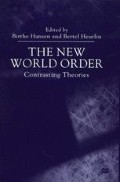The Unipolar World Order and its Dynamics
Cite this chapter.

- Birthe Hansen
222 Accesses
5 Citations
Since 1989 the academic debate on how to address the post-Cold War world order has flourished. It centres on whether the current world order is to be analysed in terms of being multipolar, still bipolar, for the moment unipolar, fragmented, in the hands of the civilizations, or democratic and peaceful. If the order is unipolar, as I assume, questions arise as to what characterizes a unipolar order in general, and what can be expected from a US unipolar order in particular.
- Great Power
- World Order
- World Politics
- International Politics
These keywords were added by machine and not by the authors. This process is experimental and the keywords may be updated as the learning algorithm improves.
I wish to thank Tom Bryder, Michael Cox, Bertel Heurlin, Carsten Jensen, Morten Kelstrup, Morten Ougaard, James Rosenau, Randall Schweller, Kenneth Waltz, Michael Williams and Ole Wæver for useful comments on earlier drafts.
This is a preview of subscription content, log in via an institution to check access.

Access this chapter
- Available as PDF
- Read on any device
- Instant download
- Own it forever
- Durable hardcover edition
- Dispatched in 3 to 5 business days
- Free shipping worldwide - see info
Tax calculation will be finalised at checkout
Purchases are for personal use only
Institutional subscriptions
Unable to display preview. Download preview PDF.
Christensen, T.J. and Snyder, J. (1990) ‘Chain Gangs and Passed Bucks: Predicting Alliance Patterns in Multipolarity’, International Organization , vol. 44 (2).
Google Scholar
Freedman, L. and Karsh, E. (1993) The Gulf Conflict 1990–91 ( London: Faber & Faber ).
Garnham, D. (1991) ‘Explaining Middle Eastern Alignments During the Gulf War’, The Jerusalem Journal of International Relations , vol. 13 (3).
Hansen, B. (1997) Unipolarity and the Middle East ( London: Curzon Press).
Jensen, C. (1997) ‘Hegemony, Internationalization and the New World Order’, DUPI Conference Paper.
Jonson, L. (1997) ‘Russia and the “Near Abroad”’, in B. Hansen and B. Heurlin (eds), The Baltic States in World Politics ( London: Curzon Press ).
Morrow, J.D. (1991) ‘Alliances and Asymmetry: An Alternative to the Capability Aggregation Model’, American Journal of Political Science , vol. 35 (4).
Schweller, R.L. (1992) ‘Domestic Structure and Preventive War: Are Democracies More Pacific?’, World Politics , vol. 44 (2).
Snyder, G.H. (1984) The Security Dilemma in Alliance Politics’, World Politics , vol. xxxvi (4).
Walt, S.M. (1987) The Origins of Alliances ( Ithaca: Conrnell University Press).
Walt, S.M. (1988) ‘Testing Theories of Alliance Formation: The Case of Southwest Asia’, International Organization , vol. 42 (2).
Waltz, K.N. (1979) Theory of International Politics ( New York: Random House).
Waltz, K.N. (1995) ‘The United States and the New World Order’, in B. Hansen (ed.), European Security 2000 ( Copenhagen: Political Studies Press ).
Download references
You can also search for this author in PubMed Google Scholar
Editor information
Editors and affiliations.
University of Copenhagen, Denmark
Birthe Hansen ( Associate Professor in International Politics, Senior Adviser ) & Bertel Heurlin ( Jean Monnet Professor in European Integration and Security ) ( Associate Professor in International Politics, Senior Adviser ) & ( Jean Monnet Professor in European Integration and Security )
Danish Institute of International Affairs, Denmark
Copyright information
© 2000 Birthe Hansen

About this chapter
Hansen, B. (2000). The Unipolar World Order and its Dynamics. In: Hansen, B., Heurlin, B. (eds) The New World Order. Palgrave Macmillan, London. https://doi.org/10.1057/9781403905277_5
Download citation
DOI : https://doi.org/10.1057/9781403905277_5
Publisher Name : Palgrave Macmillan, London
Print ISBN : 978-1-349-42325-5
Online ISBN : 978-1-4039-0527-7
eBook Packages : Palgrave Political & Intern. Studies Collection Political Science and International Studies (R0)
Share this chapter
Anyone you share the following link with will be able to read this content:
Sorry, a shareable link is not currently available for this article.
Provided by the Springer Nature SharedIt content-sharing initiative
- Publish with us
Policies and ethics
- Find a journal
- Track your research

IMAGES
VIDEO
COMMENTS
The Unipolar World Order and its Dynamics Birthe Hansen1 112 Since 1989 the academic debate on how to address the post-Cold War world order has flourished. It centres on whether the current world order is to be analysed in terms of being multipolar, still bipolar, for the moment unipolar, fragmented, in the hands of the civilizations, or